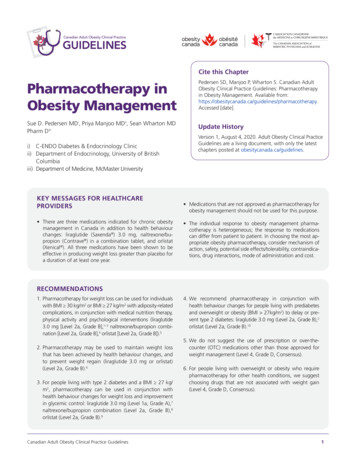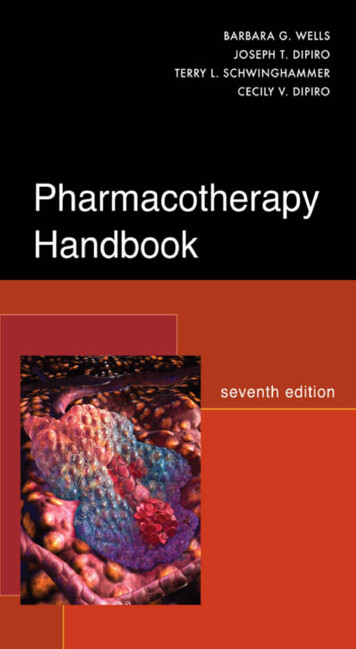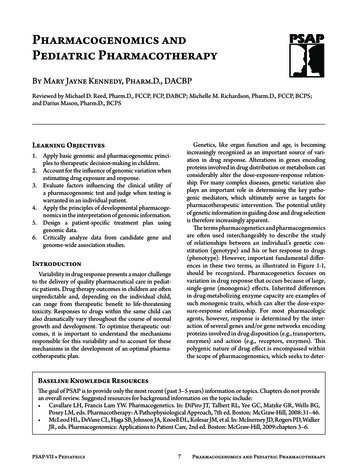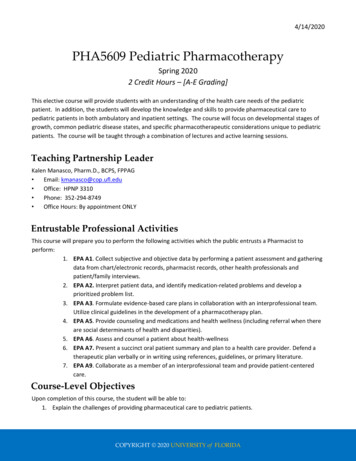
Transcription
Cite this ChapterPharmacotherapy inObesity ManagementPedersen SD, Manjoo P, Wharton S. Canadian AdultObesity Clinical Practice Guidelines: Pharmacotherapyin Obesity Management. Available herapy.Accessed [date].Sue D. Pedersen MDi, Priya Manjoo MDii, Sean Wharton MDPharm DiiiUpdate Historyi) C-ENDO Diabetes & Endocrinology Clinicii) Department of Endocrinology, University of BritishColumbiaiii) Department of Medicine, McMaster UniversityKEY MESSAGES FOR HEALTHCAREPROVIDERS There are three medications indicated for chronic obesitymanagement in Canada in addition to health behaviourchanges: liraglutide (Saxenda ) 3.0 mg, naltrexone/bupropion (Contrave ) in a combination tablet, and orlistat(Xenical ). All three medications have been shown to beeffective in producing weight loss greater than placebo fora duration of at least one year.Version 1, August 4, 2020. Adult Obesity Clinical PracticeGuidelines are a living document, with only the latestchapters posted at obesitycanada.ca/guidelines. Medications that are not approved as pharmacotherapy forobesity management should not be used for this purpose. The individual response to obesity management pharmacotherapy is heterogeneous; the response to medicationscan differ from patient to patient. In choosing the most appropriate obesity pharmacotherapy, consider mechanism ofaction, safety, potential side effects/tolerability, contraindications, drug interactions, mode of administration and cost.RECOMMENDATIONS1. Pharmacotherapy for weight loss can be used for individualswith BMI 30 kg/m2 or BMI 27 kg/m2 with adiposity-relatedcomplications, in conjunction with medical nutrition therapy,physical activity and psychological interventions (liraglutide3.0 mg [Level 2a, Grade B],1–3 naltrexone/bupropion combination [Level 2a, Grade B],4 orlistat [Level 2a, Grade B]).52. Pharmacotherapy may be used to maintain weight lossthat has been achieved by health behaviour changes, andto prevent weight regain (liraglutide 3.0 mg or orlistat)(Level 2a, Grade B).63. For people living with type 2 diabetes and a BMI 27 kg/m2, pharmacotherapy can be used in conjunction withhealth behaviour changes for weight loss and improvementin glycemic control: liraglutide 3.0 mg (Level 1a, Grade A),7naltrexone/bupropion combination (Level 2a, Grade B),8orlistat (Level 2a, Grade B).9Canadian Adult Obesity Clinical Practice Guidelines4. We recommend pharmacotherapy in conjunction withhealth behaviour changes for people living with prediabetesand overweight or obesity (BMI 27kg/m2) to delay or prevent type 2 diabetes: liraglutide 3.0 mg (Level 2a, Grade B),2orlistat (Level 2a, Grade B).105. We do not suggest the use of prescription or over-thecounter (OTC) medications other than those approved forweight management (Level 4, Grade D, Consensus).6. For people living with overweight or obesity who requirepharmacotherapy for other health conditions, we suggestchoosing drugs that are not associated with weight gain(Level 4, Grade D, Consensus).1
KEY MESSAGES FOR PEOPLE LIVINGWITH OBESITY Obesity medication can help you in your obesity management journey when health behaviour changes alone havenot been effective or sustainable. There are three medications approved for long-term obesitymanagement in Canada: liraglutide 3.0 mg (Saxenda ),naltrexone/bupropion in a combination tablet (Contrave )and orlistat (Xenical ). These medications can help you toachieve and maintain a 5%–10% weight loss and improveIntroductionModest and sustained weight loss (5%–10%) is associated withimprovements in comorbidities associated with obesity.11–13 Healthbehaviour modifications are the cornerstone of obesity management; however, health behaviour changes alone are often not sufficient for achieving obesity management goals. Health behaviourmodification generally achieves only a 3%–5% weight loss, whichis most often not sustained over the long term (see the chapterEffective Psychological and Behavioural Interventions in ObesityManagement). Pharmacotherapy for obesity should be consideredto decrease weight and improve metabolic and/or health parameters when health behaviour change alone has been ineffective,insufficient or without sustained benefit.This chapter provides a review of the literature pertaining to theefficacy of the obesity medications currently approved by HealthCanada. It is intended to inform primary care practitioners andspecialists on the appropriate use of obesity pharmacotherapy.Health Canada has established the following criteria that must besatisfied for a pharmacotherapeutic agent to receive regulatoryapproval for chronic obesity management:1. The agent must be studied in clinical trials of at least one yearin duration.2. The agent must induce a placebo-adjusted mean weight loss of 5% or must demonstrate a 5% weight loss in at least 35%of patients, with this proportion being more than double thatin placebo.3. The agent should demonstrate an improvement in obesity-relatedcomorbidities.Pharmacotherapy is indicated for chronic obesity management inCanada for individuals with a body mass index (BMI) 30 kg/m2,or 27 kg/m2 with comorbidities associated with excess body fat(e.g., type 2 diabetes [T2DM], hypertension, dyslipidemia).There are three medications approved for obesity management inCanada: orlistat, liraglutide 3.0 mg and naltrexone/bupropion. ItCanadian Adult Obesity Clinical Practice Guidelineshealth complications associated with excess weight. Thesemedications are approved by Health Canada and havebeen proven in robust clinical trials to be effective for obesitymanagement. Medications that are not approved for obesity treatmentmay not be safe or effective for obesity management andshould be avoided.is recognized that other medications, available in Canada but notapproved for obesity management, are used off-label for obesitymanagement. As a result, our literature search employed an openstrategy to capture all pharmacotherapy agents that have beenstudied for obesity management. However, with the exception ofmetformin for prevention of antipsychotic-induced weight gain(see The Role of Mental Health in Obesity Management for themetformin recommendation), we discourage healthcare providersfrom using agents solely for chronic obesity management if they donot have regulatory approval for this indication. Non-prescriptiontreatments/supplements are reviewed separately in the CommercialProducts and Programs in Obesity Management chapter.This chapter will address clinical questions pertaining to the efficacy of pharmacotherapy in people with overweight or obesity.It will also summarize evidence for pharmacotherapy for obesityamong persons with selected comorbidities, including T2DM, prediabetes, hepatic steatosis, polycystic ovary syndrome, obstructivesleep apnea and osteoarthritis. Randomized controlled trials ormeta-analyses of at least six months duration were included in theliterature review.Considerations in the use of pharmacotherapyfor obesity managementThere are several factors to be taken into consideration in determining the appropriate choice of pharmacotherapy for patientswith overweight or obesity. The etiology of obesity is complex andheterogeneous. Psychosocial, emotional and hedonic contributorsof obesity should be diagnosed and managed where possible. Themechanism of action, adverse side effects, safety and tolerabilityof each agent must be considered in the context of each patient’scomorbidities and existing medications. The cost of medicationsas well as the mode (oral versus subcutaneous) and frequency ofadministration can be a barrier to patient adherence and shouldbe discussed. It is important to assess concomitant medicationsthat a patient is taking as possible contributors to weight gain andto consider alternatives where appropriate.If clinically significant weight loss is not achieved with pharmacotherapy, other factors contributing to perceived pharmacotherapy failureshould be assessed, including inappropriate dosing or adherence,2
barriers to health behaviour change and psychosocial or medical issues. It should also be recognized that there is considerableheterogeneity in the response to pharmacotherapy with any pharmacotherapeutic agent. Consideration should be given to tryinganother obesity medication or obesity management therapy ifclinically significant obesity management success has not beenachieved after three months on full/maximum-tolerated dose andno other evident etiologies of the lack of success are apparent.Currently, we have no ability to predict which medication willbenefit a patient most. With the evolution of precision medicine,including hormonal and genetic profiling, it may in the future become possible to predict which pharmacotherapy may benefit anindividual patient the most.Regulatory agencies recommend discontinuing pharmacotherapyfor obesity if weight loss of 5% has not been achieved afterthree months on therapeutic dose. However, pharmacotherapycan also be used to maintain weight loss achieved with a priorhealth behaviour change or a very low energy diet.3,6Obesity medications are intended as part of a long-term treatmentstrategy. Clinical trials for obesity pharmacotherapy consistentlydemonstrate regain of weight when active treatment is stopped.2,14The use of obesity pharmacotherapy is not recommended in pregnant or breastfeeding women, or in women who are trying to conceive. There is no data available to inform on the timing of thediscontinuation of obesity pharmacotherapy prior to conception.Mechanism and efficacy of approvedpharmacotherapy for obesity managementOrlistatOrlistat, a semisynthetic derivative of lipstatin, was approved aspharmacotherapy for obesity management in Canada in 1999(see Table 1). It is a potent and selective inhibitor of pancreaticlipase, thereby inhibiting the breakdown of dietary triglyceridesinto absorbable free fatty acids. As a result of this, approximately30% of ingested triglycerides are excreted, primarily in the feces,creating a caloric deficit.15To date, orlistat is the only available obesity medication that doesnot specifically target appetite or satiety mechanisms.Orlistat at a dose of 120 mg three times daily (taken during orup to one hour after meals) is approved by Health Canada forweight reduction or reducing the risk of weight regain after priorweight loss in patients with a BMI 30kg/m2 or BMI 27 kg/m2 inthe presence of comorbidities (e.g., hypertension, T2DM, dyslipidemia, excess visceral fat).16A systematic review and meta-analysis of randomized controlledtrials of orlistat 120 mg three times a day reported a mean placebosubtracted weight loss of -2.9% at one year.5 Additionally, 54%and 26% of patients achieved 5% and 10% weight loss,Canadian Adult Obesity Clinical Practice Guidelinesrespectively, compared to 33% and 14% for placebo.5 Orlistat hasbeen shown to be effective in maintaining weight loss after a verylow energy diet for eight weeks, with less weight regain in the orlistat arm compared to placebo over three years (4.6 kg vs. 7.0 kg).6Orlistat therapy is associated with significant adverse gastrointestinal effects, including oily spotting and stool, flatus with discharge,fecal urgency and increased defecation.5 These adverse effectsmay cause patients who do not lower their dietary fat intake todiscontinue therapy. A long-term analysis of obesity medicationsin Canada demonstrated six-month, one-year and two-year persistence rates of 18%, 6% and 2% with orlistat, respectively.17Orlistat therapy may interfere with the absorption of fat-solublevitamins (A, D, E and K), and patients should thus be counselledto take a multivitamin at least two hours before or after takingorlistat.5,16 Orlistat is contraindicated in patients with chronic malabsorption syndrome or cholestasis. Some patients may developincreased levels of urinary oxalate on orlistat; cases of oxalate nephropathy with renal failure have been reported.18 There have alsobeen rare cases of severe liver injury or acute liver failure.19As orlistat may interfere with vitamin K absorption, internationalnormalized ratio should be monitored closely when oral anticoagulants are co-administered. Orlistat may affect absorption oflevothyroxine and/or iodine salts; patients on levothyroxine shouldbe monitored for changes in thyroid function. A reduction in plasma cyclosporine levels has been observed when orlistat is co-administered; thus, it is recommended to monitor cyclosporine levelsmore frequently. Orlistat may affect absorption of anticonvulsants,so patients on anticonvulsants should be monitored for possiblechanges in the frequency and/or severity of seizure.16The minimal weight loss with orlistat above placebo, as well as itsfrequent gastrointestinal side effects, limit its use as therapy forobesity management.LiraglutideLiraglutide is a daily, subcutaneously administered, human glucagon-like peptide 1 (GLP-1) analog that acts centrally on thepro-opiomelanocortin (POMC)/CART neurons to improve satiationand satiety and reduce hunger, with a transient effect to decreasegastric emptying.20,21Liraglutide increases insulin release and suppresses glucagonduring times of glucose elevation. Liraglutide is approved in Canada for the management of T2DM at a dose of 1.2 mg or 1.8 mgdaily, with near maximal therapeutic efficacy for A1C lowering atthe 1.8 mg dose. Liraglutide was approved in Canada in 2015 forchronic obesity management at a dose of 3.0 mg daily, in peoplewith or without type 2 diabetes. The recommended starting doseof liraglutide is 0.6 mg daily, with up-titration by 0.6 mg eachweek until the 3.0 mg target dose is achieved.Among people with normoglycemia or prediabetes, liraglutide 3.0mg with health behaviour modification resulted in an 8.0% weightloss at one year, compared to 2.6% on placebo (health behaviour3
Table 1. Pharmacotherapy for ObesityOrlistatLiraglutideNaltrexone/BupropionMode of 0 mg TID3.0 mg daily16/180 mg BIDEffect on % weight loss at 1 year,placebo subtracted-2.9%5-5.4%1-4.8%4Effect on weight over longer term,placebo subtracted-2.8kg at 4 years10-4.2% at 3 years2Not studied% of patients achieving 5%weight loss at 1 year54% (vs. 33% in placebo)563.2% (vs. 27.1% in placebo)148% (vs. 16% in placebo)4% of patients achieving 10%weight loss at 1 year26% (vs. 14% in placebo)533.1% (vs. 10.6% in placebo)125% (vs. 7% in placebo)4Effect on maintenance of previousweight loss2.4kg less weight regain vs.placebo over 3 years6-6.0% additional placebo-subtractedweight loss at 1 year3Not studiedEffect on prediabetes37.3% reduction in risk ofdeveloping T2DM over 4 years1079% reduction in risk of developingT2DM over 3 years2Not studiedEffect on BP at 1 year,placebo subtracted-1.9 mmHg SBP-1.5 mmHg DBP22-2.8mmHg SBP-0.9mmHg DBP1 1.8mmHg SBP0.9mmHg DBP4Effect on lipids at 1 year, placebosubtracted- 0.27 mmol/L total chol- 0.21 mmol/L LDL- 0.02 mmol/L HDL- 0.00 mmol/L TG22-2.3% total chol-2.4% LDL 1.9% HDL-3.9% nonHDL-9.3% TG1-1.5 % LDL 7.2% HDL- 9.6 % TG4Effect on HR at 1 year,placebo subtractedNo change 2.4 BPM1 1.1 BPM4Effect on A1C in patients with diabetes at 1 year, placebo subtracted-0.4%9-1.0%7-0.5%8Effect on NASHNo improvementImprovement23Not studiedEffect on PCOSNot studied-5.2 kg placebo subtracted weightloss at 6mo; no data on menstrualcyclicity24Not studiedEffect on OANot studiedNot studiedNot studiedEffect on OSANot studiedReduces AHI by 6/hrNot studiedCost Contraindications Cholestasis Chronic malabsorption syndrome16 Pregnancy Past history of pancreatitis Personal or family history ofmedullary thyroid cancer Personal history of MEN2syndrome Pregnancy Uncontrolled hypertension Any opioid use History of, or risk factors for, seizure Abrupt discontinuation of alcohol Concomitant administration ofmonoamine oxidase inhibitors (MAOI) Severe hepatic impairment End-stage renal failure PregnancyCommon side effectsLoose, oily stools, flatusNausea, constipation, diarrhea,vomitingNausea, constipation, headache, drymouth, dizziness, diarrheaRare side effects Liver failure Nephrolithiasis Acute kidney injuryPancreatitis Cholelithiasis Seizure Worsening of depressionDrug interactions Fat-soluble vitamins Levothyroxine Cyclosporine Oral anticoagulantsanticonvulsants16May affect absorption of medications due to slowing of gastricemptyingYes: See chapter textCanadian Adult Obesity Clinical Practice Guidelines254
modification alone).1 In terms of categorical weight loss, 63.2%of patients on liraglutide lost 5% body weight at one year, compared with 27.1% of patients in the placebo group;1 33.1% and10.6% of participants lost more than 10% of their body weighton liraglutide 3.0 mg and placebo, respectively. Patients with prediabetes were followed to three years, with sustained weight lossof -6.1% in the liraglutide group vs. -1.9% in placebo.2Following a -6.0% weight loss with a low-calorie diet, liraglutide3.0 mg plus health behaviour counselling reduced weight by afurther -6.2% at one year compared with -0.2% in the placebo group (ongoing health behaviour counselling alone). Morepatients on liraglutide 3.0 mg were able to maintain the 5%run-in weight loss (81.4%) compared with those receiving placebo (48.9%). Fewer patients on liraglutide 3.0 mg regained 5%body weight (1.9%) compared to placebo (17.5%).3The most common side effect of liraglutide is nausea due to atransient decrease in gastric emptying. Patients may also experience constipation, diarrhea, heartburn and/or vomiting. Moregradual titration can help mitigate gastrointestinal side effects,should these occur. Liraglutide use is associated with a 1.4% higher risk of gallstones compared to placebo.26There is a small increased risk of pancreatitis compared to placebo,with the majority of these cases seen in association with gallbladderdisease.2 Liraglutide is contraindicated in patients with a personal orfamily history of medullary thyroid cancer or a personal history ofmultiple endocrine neoplasia type 2 because of an increased risk ofmedullary thyroid cancer seen in rodent studies. There have beenno cases of medullary thyroid cancer in human studies of liraglutide. Liraglutide delays gastric emptying, which may impact absorption of concomitantly administered oral medications.Naltrexone/BupropionNaltrexone hydrochloride/bupropion hydrochloride is a combination of two medications. Naltrexone is an opioid receptor antagonist that has been used for decades for the treatment of alcoholand opioid dependence. Bupropion is a widely used antidepressantthat inhibits the reuptake of dopamine and norepinephrine. Thenaltrexone/bupropion sustained release formulation was approvedfor chronic obesity management in Canada in 2018, at a totaldaily dose of 32 mg naltrexone and 360 mg bupropion. Bupropion induces satiety centrally by enhancing production and releaseof α-melanocyte stimulating hormone (α-MSH) and β-endorphinfrom the pro-opiomelanocortin cells in the arcuate nucleus of thehypothalamus. Naltrexone disrupts the auto-inhibitory effect ofβ-endorphin on the pro-opiomelanocortin cells by blocking theμ-opioid receptors. Naltrexone/bupropion also influences the mesolimbic reward system to reduce cravings.27 This synergistic modeof action is supported by the evidence that the use of bupropion ornaltrexone alone do not lead to clinically meaningful weight loss.28Each tablet of the naltrexone/bupropion combination contains 8 mg ofnaltrexone and 90 mg of bupropion. The recommended titrationCanadian Adult Obesity Clinical Practice Guidelinesschedule is one tablet daily for the first week, with an increase byone tablet each week until the maintenance dose of two tabletstwice daily (total daily dose 32 mg/360 mg) is reached.Among patients with overweight or obesity without diabetes, naltrexone/bupropion 32 mg/360 mg with a hypocaloric diet (500kcal/day deficit) and exercise was associated with weight loss of-6.1% versus -1.3% in placebo.4 A 5% weight loss was seenin 48% of patients, and 10% weight loss was seen in 25% ofpatients, compared with 16% and 7% in the placebo groups,respectively.4 A combined analysis of three naltrexone/bupropiontrials found that early improvements in cravings were predictive ofgreater weight loss success.29The most common side effects of naltrexone/bupropion includenausea, constipation, headache, vomiting, insomnia, dry mouth,dizziness and diarrhea. Most nausea events occur during the doseescalation period and are transient.Naltrexone/bupropion is contraindicated in patients with uncontrolled hypertension (see Other cardiovascular risk factors, sectionbelow). Any opioid use is an absolute contraindication to the useof naltrexone/bupropion. Opioid therapy should be discontinuedfor seven to 10 days prior to initiation of naltrexone/bupropionto prevent the precipitation of opioid withdrawal.30 As bupropionis associated with a slightly increased risk of seizure, naltrexone/bupropion is contraindicated in seizure disorders, anorexia nervosa, bulimia or patients undergoing abrupt discontinuation ofalcohol, benzodiazepines, barbiturates or antiepileptic drugs. Naltrexone/bupropion should be dosed with caution with any drugsthat lower seizure threshold. Monoamine inhibitors (MOAIs) canincrease the risk of hypertensive reactions, and naltrexone/bupropion should therefore not be used within 14 days of taking monoamine inhibitors. Naltrexone/bupropion should not be taken witha high fat meal ( 55% fat), as this significantly increases systemicexposure to the medication.31There are multiple potential drug interactions with naltrexone/bupropion, which stem from the effect of bupropion and its metabolites to inhibit the hepatic CYP2D6 enzyme system. Physiciansand pharmacists must be aware of the importance of evaluatingpotential drug interactions prior to initiating naltrexone/bupropion. Among patients already receiving naltrexone/bupropion, medications metabolized by CYP2D6 should be started at the lowerend of their recommended dosage range with cautious titration(e.g., selective serotonin reuptake inhibitors, beta blockers, antipsychotic agents, type 1C antiarrhythmic agents and many tricyclic antidepressants, such as citalopram, metoprolol, risperidone,propafenone and desipramine, respectively).32 For patients alreadyreceiving these medications, consideration should be given fordose reduction when starting naltrexone/bupropion. Bupropionmay result in reduced efficacy of tamoxifen and should thereforenot be used in combination with it.Bupropion is primarily metabolized by the CYP2B6 enzyme system.Therefore, naltrexone/bupropion dosing should not exceed one tablet twice daily when used with CYP2B6 inhibitors (e.g., ticlopidine,5
clopidogrel).33 Naltrexone/bupropion should be avoided in patientstaking CYP2B6 inducers as these may reduce efficacy of naltrexone/bupropion by reducing bupropion exposure (e.g., ritonavir, lopinavir,efavirenz, carbamazepine, phenobarbital, phenytoin).32 Central nervous system toxicity can occur when naltrexone/bupropion is usedconcomitantly with dopaminergic drugs (e.g., levodopa, amantadine).Impaired fasting tolerance normalized in 77% of exenatide treated patients compared with 56% in the placebo group. Exenatideis not indicated for obesity management, nor for the preventionof T2DM.Type 2 diabetes mellitusEfficacy of pharmacotherapy on healthparametersType 2 diabetes mellitus preventionT2DM is a common complication of obesity, and prevention ofdiabetes is an important goal in chronic obesity management.People with prediabetes are at high risk of developing T2DM, withabout 25% of individuals with either impaired fasting glucose orimpaired glucose tolerance progressing to T2DM over three tofive years.34 Among individuals with prediabetes, one kilogram ofweight loss is associated with a 16% relative risk reduction in thedevelopment of T2DM.35Pharmacotherapy for obesity can be of benefit to prevent or delaythe development of T2DM. Orlistat was evaluated for diabetesprevention in a trial of 3305 patients with obesity and either normal (79%) or impaired (21%) glucose tolerance. Patients wererandomized to health behaviour changes plus either orlistat orplacebo.10 After four years of treatment, the cumulative incidenceof diabetes was 6.2% in the orlistat group compared with 9.0%in placebo, with a corresponding 37.3% decrease in risk of progression to T2DM. People with impaired glucose tolerance derivedthe greatest benefit in terms of decreased rate of progression toT2DM, compared to study participants with normoglycemia. Asecondary analysis demonstrated greater weight loss to be theprimary reason for diabetes prevention.10Liraglutide 3.0 mg has demonstrated efficacy to prevent and delay T2DM amongst people with prediabetes. The SCALE Obesityand Prediabetes trial randomized 2254 patients to receive liraglutide 3.0 mg (n 1505) or placebo (n 749), in addition to healthbehaviour change. The time to onset of T2DM over a three-yeartreatment period in this study was 2.7 times longer with liraglutide 3.0 mg vs. health behaviour alone, and the risk of developingT2DM was reduced by 79%.2 These improvements are likely dueto a combined effect of the antihyperglycemic effects of liraglutide as well as liraglutide-mediated weight loss.Currently, there are no published studies evaluating the efficacy ofnaltrexone/bupropion on diabetes prevention.Our systematic review identified one randomized control trial evaluating the efficacy of exenatide (a short acting GLP-1 analog) versus placebo on body weight and glucose tolerance among peoplewith obesity with normoglycemia, impaired glucose tolerance orimpaired fasting glucose, on a background of health behaviour intervention over a 24-week period.29 The exenatide group demonstrated a -5.1 kg weight loss compared with -1.6 kg on placebo.Canadian Adult Obesity Clinical Practice GuidelinesObesity in T2DM is associated with poorer glycemic control, bloodpressure and lipid profiles, and increased use of lipid lowering andantihypertensive drugs, compared with people with diabetes whodo not have obesity.36The effect of antidiabetic pharmacotherapy on weight should beconsidered in choosing the most appropriate medication(s) forglycemic control. GLP1 receptor agonists and sodium/glucosecotransporter 2 inhibitors are associated with weight loss in addition to improving glycemic control. Metformin, dipeptidyl peptidase-4 inhibitors and acarbose are typically weight neutral. Insulin, insulin secretagogues and thiazolidinediones are associatedwith weight gain.37 Pharmacotherapy for obesity can be of benefitfor weight loss and improved diabetes control.Orlistat has been demonstrated to improve glycemic control in patients with T2DM. A meta-analysis comprising 2550 patients withT2DM and obesity randomized to orlistat 120 mg tid or placebofound that patients treated with orlistat had significantly greatermean decreases in fasting plasma glucose and HbA1c comparedwith placebo (1.39 mmol/l vs. 0.47 mmol/l and 0.74% vs. 0.31%,respectively).9 Weight loss in the orlistat group was -3.8 kg compared to -1.4 kg on placebo. The primary reason for improvementin glycemic control with orlistat is weight loss, although orlistat mayprovide beneficial metabolic effects independent of weight loss. Forpatients with minimal weight loss (1% of baseline body weight), orlistat provided a significantly greater decrease in fasting plasma glucose (0.83 mmol/l vs. 0.02 mmol/l) and HbA1c (0.29% vs. 0.14%).9In the SCALE diabetes trial, liraglutide 3.0 mg was compared to liraglutide 1.8 mg and placebo, in addition to health behaviour changes, in people with obesity and T2DM managed with oral agents orhealth behaviours alone. At one year, liraglutide 3.0 mg reducedweight by -6.0% (n 423) compared to -4.7% on liraglutide 1.8mg (n 211) and -2.0% on placebo (n 212). A clinically significantweight loss of 5% was achieved by 54.3% of patients on liraglutide 3.0 mg, versus 40.4% on liraglutide 1.8 mg and 21.4% onplacebo. Weight loss 10% occurred in 25.2% of patients on liraglutide 3.0 mg versus 15.9% with liraglutide 1.8 mg versus 6.7%of people receiving health behaviour modification alone. Liraglutide3.0 mg reduced HbA1c by 1.3% compared with 1.1% on liraglutide 1.8 mg and 0.3% on placebo. In addition, more participantstreated with liraglutide 3.0 mg and 1.8 mg reduced their net use oforal antihyperglycemic agents compared with placebo.7The Contrave Obesity Research Diabetes (COR-DM) trial evaluatedthe safety and efficacy of naltrexone/bupropion 32 mg /360 mg inaddition to health behaviour changes amongst adults with a BMIof 27–45 kg/m2 and T2DM managed with oral agents or diet.86
Naltrexone/bupropion treated patients achieved a 5% weight reduction compared with 1.8% in the placebo group. Additionally, 44.5% of patients achieved 5% weight loss compared with18.9% in the placebo arm, and 18.5% of patients lost 10%weight loss compared with 5.7% of patients in the placebo arm.Patients treated with naltrexone/bupropion demonstrated a -0.5%greater improvement in A1C compared to placebo and were morelikely to achieve an A1C 7% (44.1% in the naltrexone/bupropion group versus 26.3% in placebo). The change in A1C wascorrelated with the change in body weight in both study arms.However, fewer patients receiving naltrexone/bupropion requiredan increase in dose or the addition of another oral antidiabeticagent compared with placebo (22.3% vs. 35.2%, respectively).were released after 25% of the planned number of major adverse cardiovascular events (MACE) occurred, compromising the integrity of thetrial. Although the trial was terminated upon the recommendation ofthe lead investigator, the results of the preplanned 50% interim analysis were released and demonstrated a hazard ratio for the time to thefirst major adverse car
Canadian Adult Obesity Clinical Practice Guidelines 1 KEY MESSAGES FOR HEALTHCARE PROVIDERS There are three medications indicated for chronic obesity management in Canada in addition to health behaviour changes: liraglutide . behaviour modificationsare the cornerstone of obesity manage-ment; however, health behaviour changes alone are .











